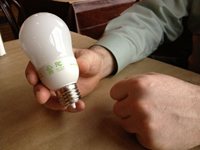 CHICAGO—More restaurants are exploring LED lights, which use less energy than incandescent bulbs and often qualify for rebates or other incentives. Energy Star, an Environmental Protection Agency program that promotes energy efficiency, estimates LEDs use at least 75 percent less energy than incandescent lights.
CHICAGO—More restaurants are exploring LED lights, which use less energy than incandescent bulbs and often qualify for rebates or other incentives. Energy Star, an Environmental Protection Agency program that promotes energy efficiency, estimates LEDs use at least 75 percent less energy than incandescent lights.
Consider these points when exploring LED lighting:
• Be prepared for an upfront investment. While LEDs cost more initially, they last 35 to 50 times longer than incandescent lighting and about two to five times longer than fluorescent lighting, according to Energy Star. Restaurants typically start to see a return on their investment in four to 16 months, says Lamon Elrod, CEO of North American LED.
• Sample different bulbs. “You could radically change the feel of the place by changing your bulbs,” says lighting architect Dan Weinreber, who advises making changes cautiously. Elrod recommends testing different LED bulbs to ensure you get the right feel. His company offers a sampler package to help with the decision-making. Some LEDs flatten woods, while others enhance them, so try the bulbs in the setting you plan to use them and test the dimming function. “Some LEDs look great at 100 percent, but their color shifts when you dim them,” says Anne Kustner Haser of Anne Kustner Lighting Design in Evanston, Ill.
• Remember: Lower temperatures equal a warmer glow. Bulbs are available in different color temperatures. Select a 2,400- to 3,000-degree Kelvin bulb for a golden glow. Once you get up to 5,000 degrees Kelvin, the bulbs produce colder, bluer light.
• Check the Color Rendering Index. This 100-point scale measures how well a light source renders colors when compared to a reference source of the same color temperature. A rating of 80 or above is optimal; 60 or below is considered poor CRI. Lighting designers note that LED colors have improved vastly in the past few years.
Lower Heating Costs with LEDs
• Stay cool. With their reduced heat load, LEDs can lower cooling costs, especially crucial in warmer climes. Haser recommends using LEDs for under-the-bar lighting to keep the counter and customers cool. LEDs also are ideal for walk-in freezers because they perform well in cold temperatures and generate minimal heat.
• Reduce your maintenance costs. Because LED bulbs last for years, there are fewer lights to change. This is especially useful with hard-to-reach bulbs and lighting aimed in a very specific direction, Weinreber says. “It keeps things locked in where intended,” he says. The directional nature of LEDs also allows for precise placement of light.
• Check for quality. Products marked with the Energy Star label have passed a variety of tests, showing they have excellent color quality, no flicker when dimmed, and light output that remains constant over time.
• Do your homework. For more tips on energy efficiency, check out the National Restaurant Association’s Conserve Sustainability Education Program. The online resource includes case studies, best practices and more than 65 how-to videos.
Click here for more information.





